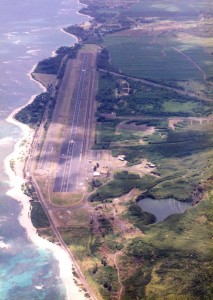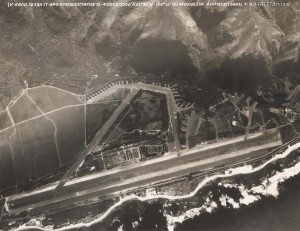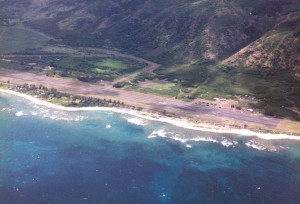Dillingham (Kawaihapai) Airfield
Army use of 67 acres of land just south of the Oahu Railroad & Land Company (OR&L) railway in Mokuleia began in 1922 with the establishment of Camp Kawaihapai as a communications station. In the 1920s and 1930s, the site was also used as a deployment site for mobile coast artillery which was transported by railroad.
By December 7, 1941, a fighter airstrip had been established on additional leased land and Mokuleia Airstrip had been established. P-40 aircraft were deployed at North Shore airstrips at Kahuku, Haleiwa and Mokuleia when the Pearl Harbor attack took place. U.S. Army Air Corps aircraft taking off from Haleiwa destroyed several attacking aircraft.
Mokuleia Airfield was improved to a 9,000-foot by 75-foot paved runway, a crosswind runway and many aircraft revetments from 1942-1945. By the end of World War II, Mokuleia Airfield could handle B-29 bombers.
In 1946, the U.S. Army acquired the additional 583 acres of leased land by condemnation with compensation. In late 1946, the U.S. Army Air Force became the U.S. Air Force by order of President Truman, so Mokuleia Airfield became an Air Force installation.
In 1948, the airfield was inactivated and renamed Dillingham Air Force Base in memory of Captain Henry Gaylord Dillingham, a B-29 pilot who was killed in action over Kawasaki, Japan on July 25, 1945. Captain Dillingham was the cousin of Walter H. Dillingham who was a noted pilot on Oahu in the 1930s. Henry was also the grandson of Benjamin F. Dillingham who founded the OR&L which evolved into Hawaiian Dredging Company and the Dillingham Corporation.
In the 1950s, a Nike Air Defense site was added near Mokuleia Beach Park but was obsolete by 1970.
The state leased Dillingham from the Air Force in 1962 for general aviation use on a short-term basis. In about 1975, the Air Force transferred the base to the Department of the Army. The state acquired a 5-year lease from the Army in 1976 and in 1983 signed a 25-year lease for the use of Dillingham Airfield as a joint Department of Defense/Civil Airport.
Hangars for fixed wing aircraft and gliders, bathrooms and a Unicom Tower/fire station were added in 1985-1986. Master plans for Dillingham were accomplished in 1980 and 1993 along with an environmental assessment in 2000.
The Defense Authorization Act of 1990 provided that the 67 acres of ceded land of old Camp Kawaihapai be transferred to the state after an agreement on future joint-use of the airfield was reached.
The 2001 Legislature passed Act 276 that changed the official name of the airfield located at Kawaihapai, formerly known as Dillingham Airfield, to Kawaihapai Airfield. The translation for the Hawaiian place name of Kawaihapai is “the carried water.” The Act will take effect upon the completion of the transfer of the airfield back to the State by the U.S. Army.
In 2004, HDH recorded 68,503 air operations, with the airfield unavailable to general aviation for only four hours due to priority military use.
In 2009, Dillingham Airfield was a general aviation airport operated by the State of Hawaii Department of Transportation, Airports Division (HDOTA) under a 25-year lease from the U.S. Army. Through four Supplemental Agreements, the term was revised, and the lease was subsequently amended to a series of five-year terms, ultimately revising the lease’s expiration date to July 2024. The lease covered 278 acres of the 650-acre Dillingham Military Reservation and supported a single 9,000-foot runway primarily used for commercial sailplane glider and sky diving operations.
The short-term lease does not allow HDOTA to comply with federal grant requirements and contains conditions that expose HDOTA to the risk of losing federal funds. In addition, water system issues, uncertainty of the lease, and lack of authority over the facility all meant that HDOTA could not guarantee the long-term operation of the airfield. Furthermore, HDOTA subsidizes about a million dollars a year for the operation and maintenance at the airfield, costs that unfairly must be paid by users of other airports in the state.
HDOTA had been working with the U.S. Army for over a decade to resolve these very difficult legal and practical problems. Over the years, HDOTA had explored many options for keeping the airfield open, however none proved viable. Dillingham Airfield is the only airport in the HDOTA system that is not owned by the state.
As a result, on January 6, 2020, HDOTA announced its decision to terminate the lease with the U.S. Army at HDH. Originally, HDOTA intended to terminate the lease as of June 30, 2020. Following the onset of the COVID-19 pandemic, HDOTA extended the proposed termination date to June 30, 2021. In connection with these announcements, HDOTA sent letters to the tenants regarding how the termination of their permits will impact them and providing instructions for returning the facility to its original condition. The letters also identified current vacancies at the other airports within HDOTA jurisdiction so tenants will have adequate time to apply for a new permit prior to the deadline to vacate HDH.
In response, the U.S. Army committed to work with HDOTA to try to resolve the current legal issues swiftly. As a result, in April 2021, HDOTA agreed to extend the lease termination date to December 31, 2021. Since April, there had been some progress on securing a new, long-term lease and Joint Use Agreement with the U.S. Army. To that end, on September 17, 2021, HDOTA agreed to rescind the termination of its lease with the U.S. Army. However, HDOTA reserved its continuing right to early termination of the U.S. Army lease if the U.S. Army did not make continued and timely progress on resolving the legal issues and issuing a new long-term lease and Joint Use Agreement. If there was no measurable progress, HDOTA would need to continue to work toward the orderly closure of HDH.
On July 20, 2023, HDOTA informed the U.S. Army that there are three critical predicates for HDOTA to be able to enter into a new lease for HDH following expiration of the current lease: (1) the U.S. Army must grant a long-term lease so that HDOTA can remain eligible for federal grants; (2) any new lease must guarantee sufficient rights and powers for HDOTA to satisfy its obligations under federal law and pursuant to federal grants; and (3) HDOTA cannot be responsible for operating the Dillingham Public Water System but must be assured access to the water necessary for the operation and maintenance of the airfield.
On December 31, 2023, the U.S. Army informed HDOTA that they have gained approval from the Assistant Secretary of the Army to negotiate a 50-year lease. The U.S. Army also noted that, while it must retain the right to review each project individually due to potential impacts on various federal regulations, it has reached preliminary agreement with HDOTA on acceptable terms to be included in a new lease. Finally, the U.S. Army noted that the Dillingham Public Water System was not included in the draft lease document. The U.S. Army will continue to work with HDOTA and other stakeholders to resolve the water system issue prior to completion of the new lease.
On January 19, 2024, HDOTA informed the U.S. Army that significant issues remain unresolved. However, given the material progress and good faith efforts by the U.S. Army to date, HDOTA is willing to continue negotiations in the strong hope of reaching an agreement in time to execute a new lease and Joint Use Agreement without any disruption to existing civilian uses. HDOTA is committed to negotiating in good faith to resolve the remaining issues.
On July 5, 2024, Governor Josh Green, M.D. issued a news release stating that the Hawaii Department of Transportation and U.S. Army Garrison Hawaii signed a 50-year lease at HDH. The new lease went into effect July 6, 2024, at which time airfield operations continued normal operations, including uninterrupted water service to the tenants and water service to nearby off-airport users. The leased area covers approximately 272 acres.
In support of the new lease, the U.S. Army established a separate five-year license with community based Aqua Engineers, Inc. to be the operator of the Dillingham Public Water System beginning July 6, 2024. This new arrangement will ensure service continues to current water users, both at the airfield and in the nearby community. Within the five-year term of the license, the U.S. Army will work with Aqua Engineers, Inc. to secure a long-term agreement for the continued operation of the Dillingham Public Water System.
Prior to any future development at Kawaihapai Airfield (formerly Dillingham Airfield), HDOTA intends to update the Master Plan, Airport Layout Plan (ALP), Noise Exposure Maps (NEM), and Noise Compatibility Program (NCP). The last Master Plan was completed in 1993, and the ALP was approved in 1993 by the FAA. The most recent FAA-accepted NEM and FAA-approved NCP were completed in 2000 and 2001, respectively.
Known as HDH, the airfield is a joint military/civil airfield with the Army having first priority for air-land operations and helicopter night-vision training. The priorities for use of HDH are (a) military flight operations, (b) military ground maneuvers and (c) civil aviation and sport parachute operations. The U.S. Army routinely conducts exercises and training where the use of the airfield is required for ground training and aviation purposes including helicopters, Unmanned Aerial Systems and cargo planes. The U.S. Army also hosts the Joint Pacific Multinational Readiness Center, a large-scale training exercise at the airfield, serving a vital role in ensuring regional combat preparedness. The airfield is not lighted for night operations by general aviation. HDOTA operates and maintains the airfield.
Related content
Dillingham Airfield Air Traffic Statistics: Kawaihapai Airfield (formerly Dillingham Airfield) is used by general aviation, sailplane glider and skydiving companies and the military.


